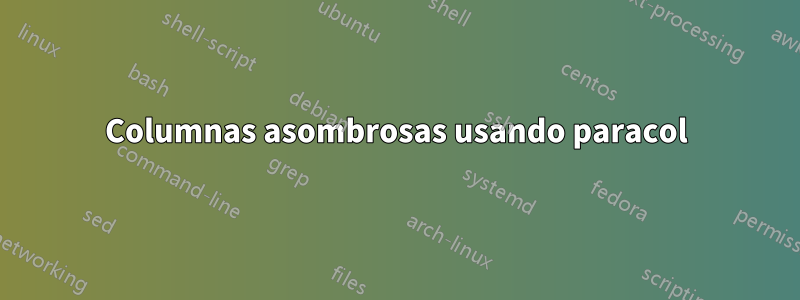
Estoy intentando crear un texto "paralelo" que sea de naturaleza temporal. Por ejemplo, el segundo autor escribió el comienzo, el primer autor escribió la segunda sección, el cuarto autor escribió la tercera sección, el tercer autor escribió la cuarta sección, el cuarto autor escribió la quinta sección, el primer autor escribió la sexta sección, etc... El texto no debe alinearse pero debe permitir al lector moverse entre estas secciones en orden. Examiné la documentación de paracol y busqué en Google el problema. Disculpas si especifiqué mal el problema o pasé por alto un recurso. He incluido un MWE. TIA.
\documentclass{report}
\usepackage[english]{babel}
\usepackage{blindtext}
\usepackage{paracol}
\begin{document}
\centering Introduction \\
\raggedright
This is an introductory paragraph. \\
The document should be able to ``bounce'' back and forth between columns. For example, columns 2, 1, 4, 3, 2, 1, 4, 3, \dots
\begin{paracol}{4}
\textbf{This is the second paragraph and should align with the bottom of the first paragraph (second column).}
\switchcolumn*[1]
\textbf{This is the first paragraph.}
\blindtext
\switchcolumn*[0]
\textbf{This is the fourth paragraph and should align with the bottom of the third paragraph (fourth column).}
\blindtext
\switchcolumn*[3]
\textbf{This is the third paragraph and should align with the bottom of the second paragraph (first column).}
\blindtext
\switchcolumn*[2]
\end{paracol}
\end{document}
Respuesta1
Puedes hacer esto conparacoly su código está muy cerca tal como está.
Si observa la compilación, los párrafos están escalonados en columnas separadas, pero simplemente saltan a una columna hacia la derecha, en lugar de a la columna especificada, y los números de columna especificados en realidad se componen. Esto se debe a que el uso previsto es \switchcolumn[i]*(lo cual posiblemente sea inusual para la sintaxis de LaTeX).
Además de eso, \switchcolumndebe aparecer antes y no después (el texto se compone inmediatamente, por lo que se escribe de acuerdo con la \switchcolumndirectiva anterior). Después de eso, el texto debe venir en el orden vertical/temporal correcto o ingresarse (junto con algún argumento para indicar el orden) en algunas macros que pueden almacenar y ordenar los párrafos según sea necesario. Naturalmente, lo primero es mucho más fácil.
\documentclass{report}
\usepackage[english]{babel}
\usepackage{blindtext}
\usepackage{paracol}
\begin{document}
This is an introductory paragraph.
The document should be able to ``bounce'' back and forth between columns. For example, columns 2, 1, 4, 3, 2, 1, 4, 3, \dots
\begin{paracol}{4}
\switchcolumn[1]*
\textbf{This is the first paragraph.}
\blindtext
\switchcolumn[0]*
\textbf{This is the second paragraph and should align with the bottom of the first paragraph (second column).}
\switchcolumn[3]*
\textbf{This is the third paragraph and should align with the bottom of the second paragraph (first column).}
\blindtext
\switchcolumn[2]*
\textbf{This is the fourth paragraph and should align with the bottom of the third paragraph (fourth column).}
\blindtext
\end{paracol}
\end{document}



